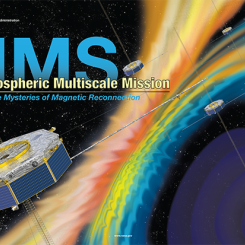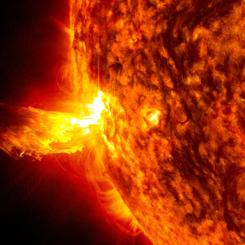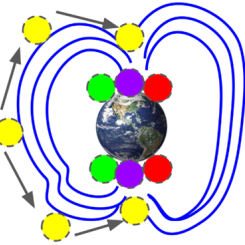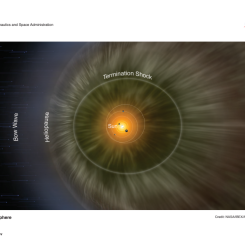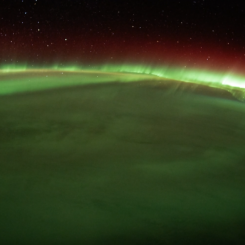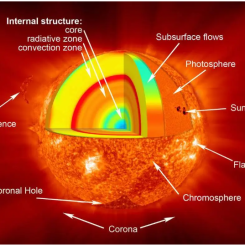Lesson Plans
Modeling Magnetic Fields
Overview
In this activity, learners investigate the properties of magnetism by using a compass to trace the magnetic field lines of a bar magnet. They then observe an animation of a coronal mass ejection (CME) interacting with Earth’s magnetosphere, noting that Earth’s magnetic field has a similar shape to that of a bar magnet. Finally, learners apply their understanding of magnetic fields to explore magnetic activity on the Sun.
Materials Required
- Modeling Magnetic Fields Handout
- Compass
- Bar magnet
- Iron filings
Procedure
Remember to never look directly at the Sun without proper safety equipment.
A very important component of understanding solar wind and predicting space weather is understanding magnetism. Both Earth and the Sun have magnetic fields.
A magnetosphere is the region around a planet dominated by the planet's magnetic field. Earth’s magnetosphere is very important to the habitability of Earth. The magnetosphere protects Earth from the solar wind and other harmful high-energy particles from the Sun. Without the magnetosphere, Earth’s atmosphere would have been scrubbed away by the solar wind and life would not have been possible on Earth.
The Sun’s magnetic field is constantly interacting with Earth’s magnetic field. Space weather describes the variations in the space environment between the Sun and Earth. In particular space weather describes the phenomena that impact systems and technologies in orbit and on Earth. When the solar wind intensifies geomagnetic storms can occur, which are disturbances in Earth’s magnetic field. The severity of a geomagnetic storm is measured by how much Earth’s magnetosphere is disturbed as a result of the solar wind.
CME Animation Model
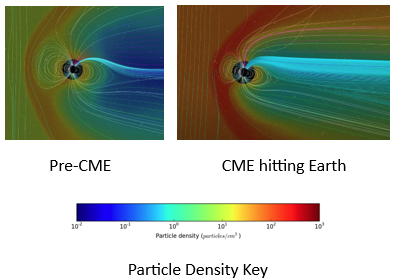
Watch this animation from NASA’s Scientific Visualization Studio Comparative Magnetospheres: A Noteworthy Coronal Mass Ejection is a computer model made from real data collected during a CME that erupted from the Sun in 2006, launching particles Earthward. These storms can interfere with the electrical infrastructure and communications on Earth and in space, which is why scientists are interested in predicting them. While the 2006 CME was not the brightest or largest solar event observed, its impact on Earth was substantial, requiring some effort to protect satellites.
Scientists at NASA and other science agencies can predict space weather by learning more about the Sun. The CME explosion does not occur until 10 seconds into the movie. As the solar wind strikes Earth's magnetic field, the magnetic fields carried by the solar wind bend and reconnect around Earth.
Note that as the movie zooms out, from a 3D image to a 2D profile of the magnetic field, it shows the density of the magnetic fields carried by the solar wind coming from the Sun, which is on the left.
The colors in the visualization show the increased density of particles caused by the CME. This visualization effectively illustrates how Earth’s magnetic field protects Earth from severe solar storms.
- The red shows the increased density of the particles coming from the Sun.
- The blue on the far side of Earth shows decreased density in the field as the energy is scattered and dissipated by Earth’s magnetic field.
Experiment: Magnetic Fields
How does a compass work?
Experiment with just the compass by moving it around and changing its orientation, instructing them to keep the magnets away from the compass. Share your observations.
What will happen when you put the compass near the magnet?
Make a prediction! Experiment with the compass and the magnet and share about your observations.
What does a magnetic field look like?
Follow the directions on how to use a compass to draw the magnetic field of the bar magnet. You can watch an instructional video to help guide you.
- Trace one of the bar magnets on a piece of paper.
- Place the compass next to the magnet, near one of the magnet’s poles.
- On the paper, mark where the needle is pointing with a dot.
- Move the compass so that the opposite end of the needle lines up with the dot.
- Repeat Step 3 – mark where the needle is pointing with a dot.
- Keep moving the compass, repeating Steps 3-4 until your compass is touching the magnet at the opposite pole.
- Connect the dots.
- Repeat Steps 2-7, starting at different points near the pole of the magnet, tracing the magnetic field lines.
- Repeat Steps 2-8 on the other side of the magnet.

Verify Results: Remember that your drawing is a 2D representation of the magnetic field around a magnet, but that the field lines go all the way around the magnet. You can verify the accuracy of your drawing by using the case of iron filings to see the magnetic field lines. Place the magnet on top of the case, notice that the iron filings show a radiation pattern from each pole, similar to the drawing you just created.
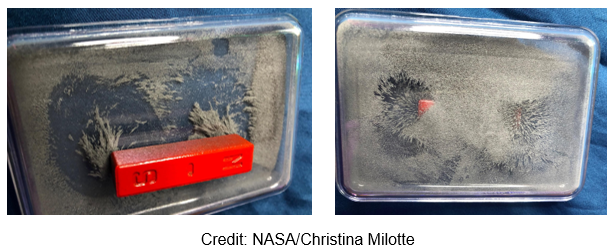
Sharing Results
Watch the video The Difference Between CMEs and Solar Flares and look for the shapes of the magnetic fields on the Sun during solar flares and CMEs.

Share your observations.
Teachers who are interested in receiving the answer key, please complete the Teacher Key Request and Verification Form. We verify that requestors are teachers prior to sending access to the answer keys as we’ve had many students try to pass as teachers to gain access.

Disciplinary Core Ideas:
- PS2B: Types of Interactions
Crosscutting Concepts:
- Patterns
- Cause and Effect
Science and Engineering Practices:
- Developing and Using Models
- Planning and Carrying out Investigations
-
Students will be able to describe the shape of a magnetic field
-
Students will be able to describe how a compass works.
-
Students will be able to identify the importance of Earth’s magnetic field and how it protects Earth from space weather.
-
How does Earth’s magnetic field protect Earth from space weather?
-
What types of solar storms cause space weather on Earth?
How does a compass work? Earth is a gigantic magnet. The small, metal needle in the compass aligns itself with Earth’s magnetic field. Magnetism is a noncontact force, meaning that magnets can affect materials without touching them. We say that a magnet creates a magnetic field, or a region of influence in the space around the magnet. Bigger magnets have larger magnetic fields than smaller magnets do
What happens when you put a compass near a magnet? When you place a compass near a magnet, the small, metal compass needle aligns with the magnetic field of the magnet. Even though Earth’s magnetic field is gigantic, a magnet has a stronger influence on a compass needle than Earth’s magnetic field does because of the magnet’s proximity to the compass.
The compass in the video is a plotting compass. If you have a gyrocompass instead of a plotting compass, simply instruct learners to orient the magnet with the poles of the Earth before drawing the magnetic field.
Major Concepts
- Both Earth and the Sun have magnetic fields.
- A magnetosphere is the region around a planet dominated by the planet's magnetic field.
- Earth’s magnetosphere protects Earth from the solar wind and other harmful effects of the Sun.
- The Sun’s magnetic field is constantly interacting with Earth’s magnetic field. Space weather describes the variations in the space environment between the Sun and Earth. In particular space weather describes the phenomena that impact systems and technologies in orbit and on Earth.
- When the solar wind intensifies geomagnetic storms can occur, which are disturbances in Earth’s magnetic field. The severity of a geomagnetic storm is measured by how much Earth’s magnetosphere is disturbed as a result of the solar wind.

